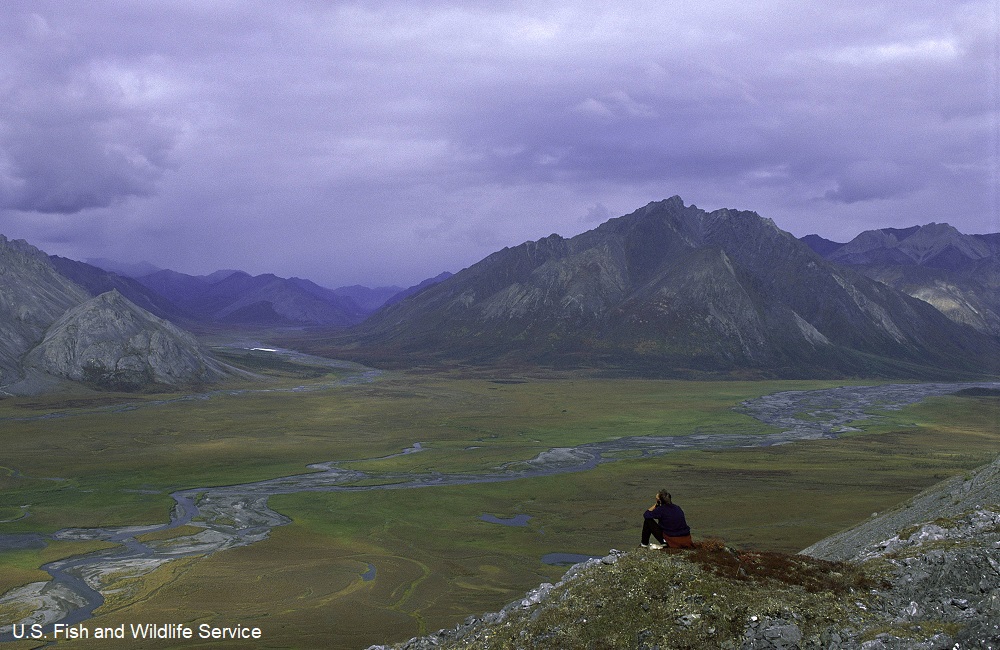GOP Tax Bailout Targets The Arctic Refuge

(This piece was written and submitted by Susan Sorg, and originally appeared on OneWildLife.) “The sacred place where life begins.” This is how the Gwich’in, the indigenous people who have lived in the Arctic Refuge wilderness for thousands of years, describe their interconnection with this land.
By: Susan Sorg
“The sacred place where life begins.” This is how the Gwich’in, the indigenous people who have lived in the Arctic Refuge wilderness for thousands of years, describe their interconnection with this land. The porcupine caribou that migrate to the Arctic Refuge’s Coastal Plain to give birth every spring are sacred to the Gwich’in. The caribou provide sustenance and food security for the Gwich’in people today, just as they have done for millennia.
About 200,000 porcupine caribou make one of the longest land migrations on the planet, travelling 800 miles round-trip to the Coastal Plain, the ‘biological heart of the Refuge,’ where they give birth to about 40,000 calves each spring.
Florian Schulz / www.florianschulz.org
This is one of the most biologically prolific and diverse wildlife nurseries on the planet, and it now faces its greatest risk.
The GOP tax plan has created a huge deficit in its quest to reduce taxes for the wealthy and corporations; the Senate Energy and Natural Resources Committee has been instructed to ‘find a way’ to generate $1 billion in revenue to offset this deficit. So, at the expense of opening up drilling on the Refuge’s pristine, irreplaceable wilderness, the Senate GOP are moving forward with their plan to open the Coastal Plain to oil and gas leasing.
The financial illogic makes this plan more confusing, since Alaska’s average lease sale between 1999 and 2016 was $50 per acre, and the Senate would need $1334 per acre to reach their $1 billion goal (Center for American Progress, 10.10.2017 – “Alaska National Wildlife Refuge 101”).
Florian Schulz / www.florianschulz.org
Thousands of caribou, Arctic fox, polar bears, grizzly bear, lynx, wolves, musk oxen, and wolverines are born on the Refuge—and the Coastal Plain is one of the most biodiverse bird nurseries on Earth with birds migrating from six continents. Over two hundred bird species migrate every spring from Africa, Asia, Antarctica, Australia, South America, and North America to nest and raise their young. Arctic tern migrate 25,000 miles, northern wheatear 26,000 miles, and tundra swans 8,000 miles. The bar-tailed godwit flies the longest nonstop distance over the Pacific—7,200 miles from Alaska to New Zealand.
Florian Schulz / www.florianschulz.org
We’re living in the Anthropocene—the sixth great extinction. Wildlife is going extinct at an exponential rate, and habitat loss and climate change are key reasons why. Eminent biologist E. O. Wilson, author of Half Earth: Our Planet’s Fight for Life has begun the movement “Nature Needs Half” to conserve half of Earth’s habitat and halt the dire loss of wildlife. How could government possibly consider a short-sighted tax plan that would allow exploitation of our last real wilderness, irreversibly degrading a critical wildlife ecosystem, with the scientific and technical knowledge we have that supports the transition to renewable energy? Renewable energy is the clear direction that progressive countries are going and the only viable answer to mitigate the deadly consequences of climate change.
Although it’s faced threats throughout the years, the Arctic Refuge has a history of bipartisan support that has rejected drilling. Nearly sixty years ago, Republican President Dwight Eisenhower recognized why we must protect the Arctic Refuge, both for the wildlife that depends on it and infinite future generations of Americans.
We can visit the Arctic Refuge today and see, hear, touch, and feel the power of this natural place as it has always been. Once drilling begins, the damage is irreversible. We cannot let that happen, for so many reasons—for the Gwich’in, the caribou, the wildlife, for ourselves, for the planet.
Susan Sorg is a nature writer passionate for saving habitat and endangered species through activism and citizen science. She hikes, bikes and bird watches in Michigan’s upper and lower peninsulas. You can follow her blog at https://www.onewildlife.info/blog.
How you can help.

Take action to protect the Arctic Refuge here.
Sources:
Birds connect Arctic Refuge with the world. U.S. Fish & Wildlife Service. https://www.fws.gov/refuge/arctic/birdworldmig.html
Birds in the Arctic Refuge. https://arcticcircle.uconn.edu/ANWR/anwrbirds.html
Matt Lee-Ashley and Jenny Rowland. Arctic National Wildlife Refuge 101. 10.10.2017. Center for American Progress. https://www.americanprogress.org/issues/green/news/2017/10/10/440559/arctic-national-wildlife-refuge-101/
The White House Sees Only Dollar Signs in the Arctic. Editorial. 10.18.2017. The New York Times. https://www.nytimes.com/2017/10/18/opinion/the-white-house-sees-only-dollar-signs-in-the-arctic.html
We’re All Losers if We Drill in the Arctic Refuge. 10.19.2017. National Audubon Society. https://www.audubon.org/news/were-all-losers-if-we-drill-arctic-refuge
Arctic National Wildlife Refuge – One of America’s most important bird nurseries is under threat. National Audubon Society. https://www.audubon.org/sites/default/files/audubon_arctic_refuge_fact_sheet_october_2017.pdfs



